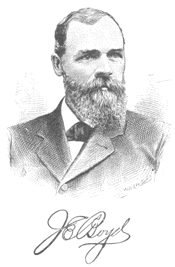Gross was established in 1893 on a quarter section of land near the center of the 27,000-acre Fort Randall Military Reserve. First called "Morton," it was rename for Ben Gross, one of the first homesteaders to the area who, together with his wife, opened a store. It is said that they waved-down passersby to tell them of the provisions they carried. This store, a post office, and possibly a trading post, were the only businesses in Gross for many years.
In anticipation of a railroad coming through Boyd County, a town developed. By 1903 there were nearly 400 inhabitants, many businesses, and a Methodist Episcopal, Church of Christ, and Christian Church. Fire destroyed Rudloff's Store in 1902, but it immediately rebuilt.
In addition to a box factory and a cheese factory, Gross also had a navigation company that ran two giant steamers from Fort Randall to Sioux City, making three trips a week. There was an army of freight teams employed to haul grain and provisions from Iron Post Landing, four miles to the east, into Gross. Texas Longhorns were also driven from Niobrara and kept in pens west of town until they were sold.
A school was started by Stella Cart in the town hall, which had been moved from Fort Randall. A one-room schoolhouse was replaced by a two-room structure in 1900. When enrollment increased to more than 100 students, another room was needed and the upper grades were added. The high school closed during World War II, and enrollment during the 1950-60s ranged from four to 30 students. In 1965 Gross became part of the Spencer District.
In 1904 there was great excitement in Gross. The population was over 600 as people waited until they were allowed to cross over into South Dakota and take homesteads on the former "Indian lands."
Later that year, however, it became evident that the railroad was not going to follow the ridge through Gross, but take the Ponca Valley instead. The exodus was immediate, as proprietors moved lock, stock, and barrel to neighboring "railroad towns."
In 1909 a great fire took many businesses and homes on the north side of the main street. Ten years later another fire reduced the south side of the street to ashes. As a result, many people moved on and no new businesses started.
Jerry Loukota ran the old general store 1940-55, and his sons, Bill and Ted, continued until 1959. Anna Loukota ran the post office until it closed in 1960. Son Jerald, who had run a repair shop and garage, opened a bar in 1957. After it changed hands and locations several times, Stu and Marge Stringfellow remodeled it and named it "Nebrask-Inn." The business, presently owned by Mike and Mary Finnegan, enjoys a large clientele from around the area who stop in for a quick lunch or socializing.
Back in the early years, recreation included several dance halls and "an open bowery." The town also had a championship baseball team in the 1920s. Softball was the main sport in recent years, but the team disbanded in 1985.
The Women's Club, organized in 1924, continues to meet. The organization's 22 members serve at funeral dinners, sales, and are the service group for the community. The Gross Cemetery, located just north of town, is well-maintained by the local residents.
During the bi-centennial, Gross had the distinction of being the smallest incorporated village in the nation. The local population was augmented by over 800 former residents and friends who came to participate in the barbecue, speeches, games, and the dedication of a tall, lighted flagpole on October 12, 1976.
The official census showed eight residents in 1970, and only two in 1980. Since the Finnegan family moved to town, the population has climbed back up to six.
The 80 acres that once was a bustling town looks much like the original prairie now, some in crops or hayed. It is not unusual to see pheasants, wild turkeys, and deer grazing nearby. Though small, Gross is still a local gathering place. Many people from surrounding communities are attracted to our town and enjoy the hospitality found in Nebraska's smallest town.


